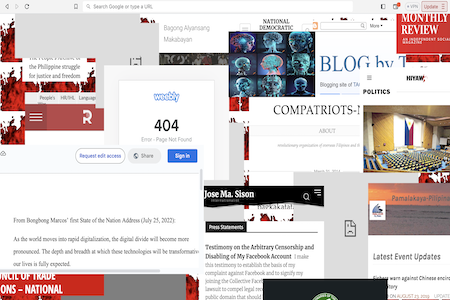
In the making and remaking of digital spaces, artists have always played a big role. When I talk about artists in this context, I mean not only the creatives that are exploring different strategies for a free and open internet; I also mean creatives that contribute to disinformation and influence operations in authoritarian governments such as the case of the Philippines, curtailing the Democratic Principles for an Open Internet.
Ever since becoming the Founding President of the UP Internet Freedom Network, a youth-led alliance of digital rights advocates based in Los Baños, Laguna, I’ve developed a trajectory that encouraged myself and others to take part in spaces and collaborate within artistic communities. Later, I established the Artists for Digital Rights Network in order to invite more creative workers to think through and work towards better shared spaces online.
As part of my work that I have been developing since the Open Internet for Democracy Leaders Program, I have presented artistic research on what I call the digital legacy of the Marcos-Duterte regime, a term I use to take into account histories, legislation, and digital life under their administration. It is through my research that I uncover and present signs of the many creative strategies that are employed to attack dissidents and sway public opinion, particularly in my home country the Philippines.
Field research in Philippine cyberspace
Enter “Full Digitalization”, a three-channel installation that I exhibited in Kunstpavillon, Innsbruck, Austria. It is a series of browser-based artworks that form patchworks exposing three different campaigns that benefit the Marcos family. In one piece, I gathered and embedded websites that had been censored during the first few months of Ferdinand Marcos Jr.’s presidency and juxtaposed them with an embedded excerpt of his first State of the Nation Address promoting his plans for “digital transformation.” Here, I wanted viewers to see how rhetoric is employed in covering up for attacks against freedom of expression.
In another piece, I presented an updated version of a previous work entitled “The Face of a Marcos Apologist,” where I morphed the faces of participants of a PR campaign on X (formerly known as Twitter) that used the hashtag #WinADateWithSandro, a contest later canceled after public backlash, where participants posted their “best selfies” for a promise of a date with Sandro Marcos, grandson of the late dictator Marcos Sr. In this updated work, I integrated photos of SIM cards alluding to the first signed legislation under Marcos’s term: the SIM Card Registration Act, which activists decry as something that will “legitimize state surveillance of ordinary Filipinos.” Privacy and data protection are key to an open internet and must be seen as important safeguards against opening up risks for targeted messaging that benefits particular political actors.
Lastly, in a piece entitled “Family Remembrance,” I archive seemingly coordinated TikTok videos from social media influencers that targeted people who took photos with a gravestone opposing the candidacy of Ferdinand Marcos, Jr. during a demonstration weeks before the 2022 presidential elections. In an earlier version of this work, I uploaded this webpage in a Raspberry Pi network that was temporarily accessible in Kunstverein Wagenhalle, Stuttgart, Germany, to expand on the idea of accessibility in the midst of content takedowns and media shutdowns happening in the Philippines.
Having an artistic practice has allowed me to think outside of the box and beyond the constraints of policy, academia, and NGO’s metrics of success. Advocating for a free and open internet needs perspectives from the arts and culture sector and I’m glad to have shared the contexts of my work in a panel at #RightsCon2023 and during the opening of the exhibit Cultura Contra Censura (an art show curated about internet shutdowns and censorship curated by Laura Schwartz-Henderson) in San Jose, Costa Rica in June 2023.
Artists’ points of view
I have regularly participated internationally in both digital rights spaces and the so-called art world. I find that while both share many common goals for a free and open internet, there are not many intersections that allow for exciting collaboration and exchange. There is so much brilliant work done and could be done in this intersection.
For example, take the work of designer Mindy Seu who published Cyberfeminism Index, an art book and website compilation that documents feminist net art, hackerspaces, and the work of digital rights groups spanning over three decades.
Or an anthology I co-edited with digital rights worker Bernz Soriano entitled Counter-Narratives brings together works by artists from the Philippines and Indonesia who attended educational workshops on disinformation with experts Nicole Curato and Marian Pastor Roses.
Public By Default, a 2017 web project by creative technologist and Mozilla Fellow Hang Do Thi Duc, narrativized the lives of unsuspecting users whose data were exposed under the US-based money-transfer app Venmo.
In envisioning a bright future for the internet, it is crucial that we include and empower creative workers in our movement. One practical step that institutions and organizations working around digital rights could take is to fund and support projects that allow artists to explore, experiment, and critique alongside our local and global initiatives.
- Log in to post comments